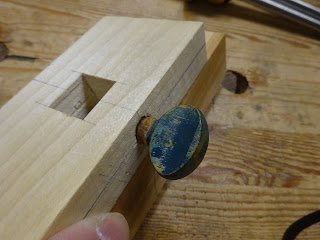This is the culmination of the wooden screw rabbit hole I've been in for several weeks. It started from a Worth marking gauge I was given some years ago, the screw from which didn't fit the inside threads in the fence very well.
 |
| It all started from this |
It turned out that the inside threads were the problem - they got wallowed out a bit and the screw would no longer hold. So with my experience a few years ago making larger wooden screws and with the help of some online videos, I figured out how to make threads of the appropriate size: 3/8" major diameter at 10 threads per inch (3/8" - 10, for short).
To pull it all together, I made a new marking gauge. The major challenge with this one was making the wooden thumb-screw. I'll get to that in a little bit. But first, I made a prototype marking gauge fence from scrap wood to see if I could create inside threads through the top and extending to the mortise that houses the beam.
 |
| And it worked very well. Here's the original wooden screw in that tapped hole - a nice snug fit. |
Later I made a fence blank from walnut and repeated the procedure on the real thing.
 |
| Here's the walnut fence getting threaded |
 |
| and I got a nice fit here, too |
 |
| The walnut took the threads pretty nicely |
Next I tested a 3/8" diameter piece of walnut to see how well it would take outside threads. I had soaked it in mineral oil for a few days, and it worked out pretty well.
 |
| Testing a 3/8" walnut dowel for outside threads |
 |
| And it fits an inside thread nicely |
With that adding confidence, I laid out a wooden screw on a walnut blank. I was careful to lay out precisely to keep things aligned.
 |
| Laid out the shape using the original as a guide |
 |
| Then sawed and rasped the to-be-threaded end a little oversize and tapped it through a dowel plate for a fairly accurate 3/8" diameter. |
The extra material on the right in the above picture is so I could mount it in the threading box. I formed that into a 5/16" diameter so I could use one of the couplers I'd already made (I realize that might only make sense if you had read the previous posts about threading small diameter wood). Then I cut the outside threads and tested them in the walnut fence.
 |
| It fits nicely and it locks the beam solidly! |
I cut off the extension on the back end and shaped the thumbscrew head similar to the original. I also cut off about 1/2" of threads so that there's only about 1/8 to 1/4" of threads above the fence when the screw locks the beam.
At this stage, there's just a little shaping to do and then some coats of shellac. Like my last marking gauge, I added wax to all outside surfaces, except the bottom of the beam. That exception will help ensure the beam won't slip in its mortise during use.
 |
| It's looking like a marking gauge |
I added measurement lines on the side of the beam that is visible to me (a right-hand dominant person) when in use. I find the lines very useful on the original Worth gauge, and I don't know why more marking gauges don't have this feature.
 |
| I laid out these lines carefully - they go out to 6" |
Almost forgot to mention - I made the pin from an old 3/32" drill bit. It was annealed (though it was still very hard after annealing) with a torch and sharpened using a drill and hand-crank grinder. It was a little loose in the 3/32" hole in the beam, so I bent it a little bit and now it holds well.
And here is the glamour shot. When the screw is tightened, the beam will not go anywhere. It clamps as solidly as a rottweiler on a postman's leg.
 |
| It's a beauty |
I'm done with wooden screws for now. It's time finally to move on to other things.



















































